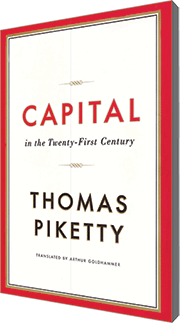Rising inequality warning
Capital in the Twenty-first Century by Thomas Piketty; Harvard Business Publishing; Price: Rs.1,495; Pages 577
 THE OUTSTANDING characteristic of this extraordinary outcome of 15 years of intensive research and scholarship is that although ex facie Capital in the Twenty-First Century is an economics text which brings great clarity to the increasingly divisive and confusing issue of wealth creation and distribution between countries and within them, it is not at all the typical dry-as-dust economics treatise. Refreshingly, this investigation into the phenomenon of rising wealth and economic disparity in countries around the world, is as much a political and even literary history of Europe and America.
THE OUTSTANDING characteristic of this extraordinary outcome of 15 years of intensive research and scholarship is that although ex facie Capital in the Twenty-First Century is an economics text which brings great clarity to the increasingly divisive and confusing issue of wealth creation and distribution between countries and within them, it is not at all the typical dry-as-dust economics treatise. Refreshingly, this investigation into the phenomenon of rising wealth and economic disparity in countries around the world, is as much a political and even literary history of Europe and America.
In tracing the evolution of capital locked in agricultural estates in the 18th century to the predominance of industrial and financial capitalism in the 20th and 21st centuries, Thomas Piketty, a professor of the Paris School of Economics, examines the novels of Honoré de Balzac and Jane Austen while conterminously debating and distinguishing the theories and postulates of renowned economists such as Malthus, Ricardo, Karl Marx and Simon Kuznets.
The starting point of this comprehensive tome is the commonplace observation that wealth and income chasms dividing the rich and poor are becoming wider in the modern globalised age. By researching British and French government tax records, Piketty establishes that wealth or capital-income ratios, which averaged 6:1 — i.e, the stock of wealth was six times GNP in Europe and the US for over two centuries — narrowed briefly during the years 1914-80 to 3-4:1 before reverting to the historical average during the past three decades. In the past 30 years, average rates of return on capital have been consistently higher — as they were in the pre-industrial revolution years — than national income growth rates, which means the income gap between owners of capital and those who live off their labour is becoming wider again.
In effect Capital is a warning that the brief interregnum of the Cold War years which ended with the collapse of the Berlin Wall in 1989, during which the gap between the return on capital and return on labour narrowed, is over. Economics Nobel Prize winner Simon Kuznets (1901-1985), citing US data relating to 1913-48, had persuasively argued that wealth and income inequality follows a ‘bell curve’ rising initially in the early stages of industrialisation and then declining sharply as economies of scale, improved logistics and rising labour incomes begin to be shared.
Especially in the 1980s during Ronald Reagan’s presidency in the US and the Thatcher years in the UK, Kuznets’ strident advocacy of economic growth based on the reasoning that a rising tide lifts all boats, became received wisdom. Reduced income taxes, abolition of estate duties and inheritance taxes, tacit acceptance of tax havens, are the consequence of the belief that releasing the animal spirits of risk-taking entrepreneurs would boost economic growth, the benefits of which would trickle down to the lowest deciles of the population.
On the contrary, the outcome of this growth-at-all-costs philosophy has been relegation of wealth/income distribution to the back burners and the global housing mortgages scandal of 2007-08, which wiped out the dreams of millions of aspiring capitalists while too-big-to-fail banks and bankers pocketed fortunes by way of generous bailouts, further widening the rich-poor divide. The fallout of ready acceptance of the logic of Kuznets Curve theory is that capital-income ratios and income inequalities in the US and Europe are as sharp today as they were a century ago, the author demonstrates with a plethora of enlightening charts and tables.
Although this study of spiralling economic disparity is essentially limited to the historical experience of “the leading developed countries” — US, Japan, Germany, France and the UK — it’s patently obvious the rate of return on capital in all developing countries, and especially in post-independence India — despite loudly proclaimed socialist pretensions — is way higher than annual rates of economic growth. The captains of India Inc who strut and preen the national stage in the warm glow of the pink press, are overwhelmingly inheritors of wealth, who by also setting their own salaries and perks have left citizens who rely on their labour for advancement, trailing far behind.
Worse, post-independence India’s beggar-thy-neighbour socialism combined with the pernicious caste system makes it almost impossible for citizens without inherited wealth/capital to rise within the socio-economic hierarchy. The few who do make it to the top through their acumen and dint of labour, are obliged to make shameful moral and ethical compromises, and/or advantageous matrimonial or patrimonial alliances described in the novels of Balzac and Austen.
Piketty’s solution for rising global wealth and income inequality is heavier taxation of the wealth of the top 10 percent — including a global income tax to reduce the gap between nation states. According to him, no national government can discharge its social obligations to the underprivileged majority without collecting 40-50 percent of GNP by way of taxes.
In developing countries (including India), the proportion of taxes to national income seldom exceeds 10-15 percent, barely enough to cover regalian responsibilities — police and judicial systems — leaving precious little for providing public education and health services. But this West-centric study doesn’t comment upon the third world reality that ubiquitous corruption, and under-developed police and judicial systems are stumbling blocks to broadening the tax base and higher revenue mobilisation, of which India is a prime example.
In his definition of capital, Piketty declines to include human capital because unlike other capital assets, (after abolition of slavery) human beings aren’t marketable. On the other hand, in developing countries such as India where rates of return on capital have outstripped rates of GNP growth for centuries, development of human capital offers the only chance of property-less individuals bridging the rich-poor chasm. And the prerequisite of human capital development is education, particularly self-education rather than establishment prescribed learning whose objective is to create a functionally literate and subservient under-class.
It’s a pity that in this brilliantly argued thesis for just and equitable societies and international order, the learned author has not examined this proposition in greater detail.
Dilip Thakore
Victorian pastiche
The Luminaries by Eleanor Catton; Granta; Price: Rs.799; Pages 832
 THE YOUNGEST Man Booker Prize winner to date, Eleanor Catton (28) of Christ Church, New Zealand, was awarded Britain’s top literary prize last year for her voluminous second novel, The Luminaries.
THE YOUNGEST Man Booker Prize winner to date, Eleanor Catton (28) of Christ Church, New Zealand, was awarded Britain’s top literary prize last year for her voluminous second novel, The Luminaries.
Set in scenic New Zealand of the 1860s during the gold rush years, the town of Hokitika on the wild west coast of South Island is suddenly crowded with prospectors, miners, prostitutes, bankers, fortune seekers, hoteliers and wealthy landlords. After a testing voyage on a barque Godspeed, Walter Moody of Edinburgh, steps into this stormy world on January 27, 1866 at the Crown Hotel and straightaway stumbles upon a secret group of 12 tense gentlemen in the smoking room.
They are discussing a set of unlikely events and coincidences — the mysterious disappearance of Emery Staines, a young miner, the near-deadly opium overdose of Anna Wetherell, a prostitute, and the demise of Crosbie Wells, a ‘hermit’, in his cottage.
Wells’ body is discovered by Alistair Lauderback, a local election candidate. In Wells’ fireplace, Lauderback discovers a charred will, and a collection of gold bricks. Tapping into all the elements of typical Victorian fiction — mystery, crime, money, competing interests, big egos, hidden letters, illegitimate children, forgeries and secret trading — Catton creates grist for this novel. In time-honoured omniscient style, she connects the seemingly random events and several intriguing relationships which prompted them.
A Victorian pastiche, the language and idioms as well as the morality and ethos of this closed society are convincingly mid-19th century. The old-fashioned story-telling technique of baring all, penetrating the minds and documenting the actions of the entire range of characters while allowing several strands of the narrative to move forward together, gives thrilling momentum to the novel. The writer indulges in the leisurely, archaic style of giving vivid descriptions of people and the actions of the villain Francis Carver, hotelier Edgar Clinch, and Lydia Wells, a vicious fortune-teller. Court and trial scenes are as much part of the narrative as meticulously reported private conversations.
Innovatively, Catton structures the narrative by taking stellar and planetary configurations as her metaphor and affirming her faith in the “vast and knowing influence of the infinite sky”. The title of the novel encapsulates changing astronomical positions which set events in motion and pre-determine human action, motivation and temperament. The character chart at the beginning is an introduction to the large cast of dramatis personae who play out their lives in the commercially transformed Maori enclaves of Hokitika.
The novel is plotted according to complex astrological calculations, stellar and planetary movements with the 12 ‘stellar’ characters corresponding to zodiac signs and seven others who form a ‘planetary’ group with only the deceased Crosbie Wells squarely on terra firma. When Moody enters the scene, he realises he has run into a cross-section of professionals — bankers, lawyers, contractors, politicians, chemists — engaged in trying to civilise convicts, Chinese ‘hatters’, gold-diggers and opium traders in the dens of Kaneire.
Twelve is the magic number of this prize winning novel comprising 12 sections, prefaced by visual representations of zodiac charts. As Catton confesses, “astrology started off as an intellectual curiosity but it has become something more and I’ve gotten slightly obsessed”. Fortune and fortune-telling are intrinsic to the novel as are seances and ghosts, and Walter Moody, the outsider trying to unearth the mysteries, is stereotypically governed by Mercury or reason. For the novelist, the extra-terrestrial influences she attempts to harness merely point to her conviction that “there is no truth except for truth in relation: nothing is objectively true, something is only true compared to something else”.
The intense human drama (rather melodrama) unfolds in the geographical context of gold prospecting and opium smuggling in 19th century New Zealand. Te Rau Tauwhare, a Maori translates the name Hokitika for Tom Balfour, an Englishman, as meaning “Around. And then back again, beginning”. That’s the shape Catton’s narrative takes — returning to the point where the story began, almost like a wheel of fortune, cycle of seasons or phases of the moon.
That’s the excitement of this novel and its spiralling movement. From a broad base — ‘a sphere within a sphere’, which takes up almost half the volume — it returns to the fateful day of January 14, 1866 and the calamitous events with which it begins.
The novel even travels backwards to 1865 to trace the origin of consequences that have already been documented.
The art of this story-teller is that she moves from the periphery to the centre, to hook the reader with surprising revelations of trysts with uncertainties which is the human condition.
Jayati Gupta














Add comment